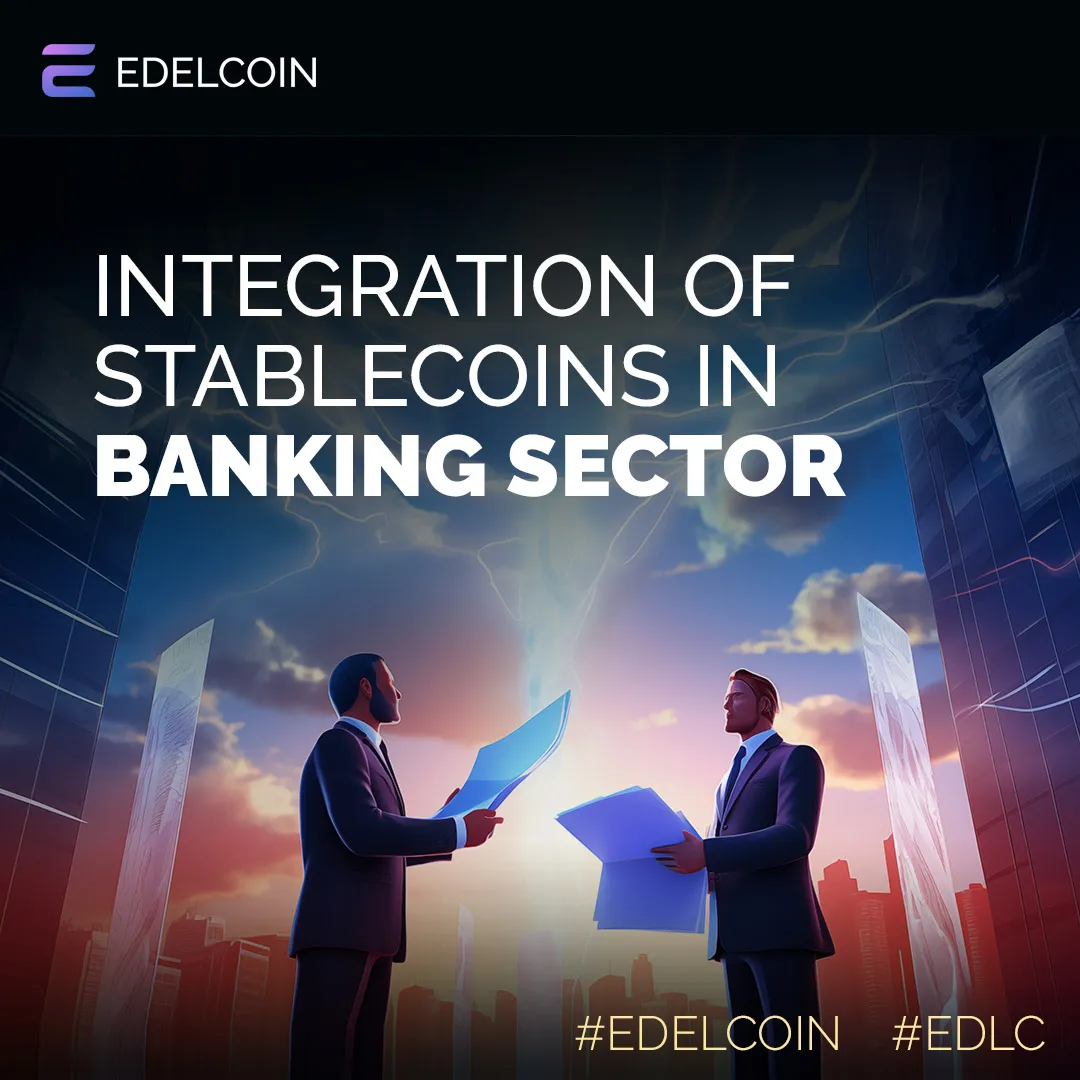
Integrating Stablecoins in Banking
Opportunities and Challenges with Edelcoin
Introduction
In the evolving landscape of finance, stablecoins have emerged as a transformative force, bridging the gap between traditional banking and the innovative world of cryptocurrencies. Unlike volatile cryptocurrencies such as Bitcoin, stablecoins are designed to maintain a stable value, often pegged to a fiat currency like the US dollar or a basket of assets. This stability makes them particularly appealing for various financial applications, including banking. This article explores the opportunities and challenges of integrating stablecoins in banking, focusing on the case of Edelcoin and its approach to navigating this complex environment.
Opportunities of Integrating Stablecoins in Banking
Enhanced Efficiency and Lower Costs
One of the primary benefits of integrating stablecoins into the banking system is the potential for enhanced efficiency and lower transaction costs. Traditional cross-border transactions can take several days and incur significant fees. Stablecoins can facilitate near-instantaneous transactions with minimal fees, making them an attractive option for international remittances and trade. For instance, the average cost of remittances globally is around 6.38% of the amount sent, according to the World Bank. In contrast, stablecoin transactions can reduce these costs to less than 1%.
Financial Inclusion
Stablecoins also hold promise for enhancing financial inclusion. Approximately 1.7 billion people worldwide remain unbanked, according to the World Bank. Stablecoins, accessible through mobile devices, can provide these individuals with access to financial services such as savings, loans, and payments. Projects like Stellar and its stablecoin integrations have made significant strides in this area, partnering with organizations like IBM to bring financial services to underbanked populations.
Transparency and Security
The blockchain technology underpinning stablecoins offers unparalleled transparency and security. Transactions are recorded on a decentralized ledger, reducing the risk of fraud and enhancing trust. This transparency is particularly valuable in the banking sector, where regulatory compliance and anti-money laundering measures are paramount. Tether (USDT), despite its controversies, has demonstrated the potential of stablecoins to provide transparent, real-time auditing capabilities, albeit with some challenges in regulatory acceptance.
Challenges of Integrating Stablecoins in Banking
Regulatory Hurdles
Regulation remains one of the most significant challenges for stablecoin integration in banking. Governments and regulatory bodies worldwide are still grappling with how to classify and regulate stablecoins. In 2020, the Financial Action Task Force (FATF) issued guidance on virtual assets, emphasizing the need for robust anti-money laundering (AML) and combating the financing of terrorism (CFT) measures. Stablecoin projects must navigate a complex web of regulations to gain acceptance and avoid legal pitfalls.
Technological Integration
Integrating stablecoins into existing banking systems poses substantial technological challenges. Banks rely on legacy systems that may not be compatible with blockchain technology. Moreover, issues related to scalability and interoperability need to be addressed. The Diem project (formerly Libra) by Facebook faced significant technological and regulatory hurdles, leading to its eventual dissolution despite substantial initial backing.
Trust and Adoption
Building trust and achieving widespread adoption are critical for the success of stablecoins in banking. Concerns about the stability of the peg, transparency of reserves, and potential for misuse can hinder adoption. For example, Tether has faced scrutiny over its claims of being fully backed by reserves, which has affected its credibility. Projects must prioritize transparency and robust reserve management to gain the trust of both consumers and financial institutions.
Real Use Cases and Successes
JPM Coin
JPMorgan Chase's JPM Coin is a notable example of stablecoin integration in banking. Launched in 2019, JPM Coin is used internally by the bank to facilitate instantaneous payments between institutional clients. This private stablecoin is pegged to the US dollar and operates on a permissioned blockchain, ensuring compliance with regulatory standards while offering the benefits of blockchain technology. JPM Coin has successfully demonstrated the potential for stablecoins to enhance efficiency within the banking sector.
USDC and Visa
Another successful case is the collaboration between Circle's USDC and Visa. In 2021, Visa announced a pilot program to enable the use of USDC for transactions on its payment network. This integration allows businesses to settle transactions with Visa in USDC, showcasing the potential for stablecoins to streamline payment processes and reduce settlement times.
Failures and Lessons Learned
Basis
Basis, a stablecoin project launched in 2017, aimed to maintain price stability through an algorithmic approach. Despite raising $133 million in funding, Basis shut down in 2018 due to regulatory concerns. The project highlighted the challenges of regulatory compliance and the importance of clear legal frameworks for stablecoin operations.
Facebook's Diem
Facebook's Diem project, initially known as Libra, faced intense regulatory scrutiny from its inception. Despite rebranding and attempting to address regulatory concerns, Diem struggled to gain approval from financial authorities and ultimately sold its assets in 2022. Diem's experience underscores the critical need for regulatory engagement and compliance in stablecoin projects.
How Edelcoin is Facing These Challenges
Edelcoin, a stablecoin backed by a basket of precious and base metals, has positioned itself as a robust and innovative player in the stablecoin market. Here's how Edelcoin addresses the challenges faced by other projects:
Regulatory Compliance
Edelcoin places a strong emphasis on regulatory compliance. The project actively engages with regulators to ensure adherence to AML and CFT standards, building trust and credibility. By maintaining transparent reserve audits and regulatory reporting, Edelcoin aims to set a high standard for regulatory compliance in the stablecoin space.
Technological Integration
Edelcoin leverages advanced blockchain technology to ensure seamless integration with existing financial systems. The project prioritizes scalability and interoperability, working with partners to develop solutions that can be easily adopted by traditional banks and financial institutions.
Transparency and Trust
Edelcoin's unique value proposition lies in its backing by a basket of precious metals, providing tangible value and stability. Regular third-party audits and transparent reporting of reserves bolster trust among users and financial institutions. This approach addresses concerns about the stability of the peg and the transparency of reserves, critical factors for widespread adoption.
Conclusion
The integration of stablecoins in banking presents a myriad of opportunities and challenges. While stablecoins like JPM Coin and USDC have demonstrated significant potential, projects like Basis and Diem highlight the importance of regulatory compliance and technological readiness. Edelcoin, with its focus on regulatory engagement, technological integration, and transparency, is well-positioned to navigate these challenges and unlock the full potential of stablecoins in the banking sector. As the financial landscape continues to evolve, Edelcoin aims to lead the way in creating a more efficient, inclusive, and secure financial system.

Test Your Knowledge
- What is one of the primary benefits of integrating stablecoins into the banking system?
a. Increased transaction costs
b. Instantaneous transactions with minimal fees
c. Limited financial inclusion
2. Which stablecoin project successfully demonstrated the potential for stablecoins to enhance efficiency within the banking sector?
a. Tether
b. JPM Coin
c. Basis
3. How does Edelcoin ensure transparency and trust among its users and financial institutions?
a. By being backed by a basket of precious metals and conducting regular third-party audits
b. By maintaining an algorithmic approach to stability
c. By relying solely on user testimonials.
Correct answers: 1b, 2b, 3a.
Contents





